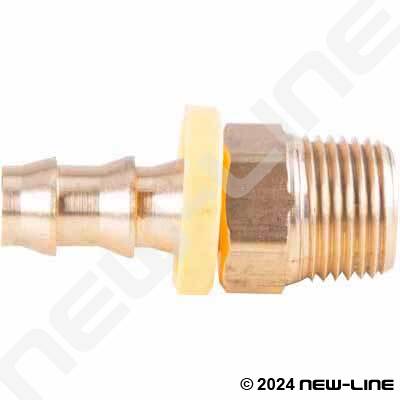the cooling line pressure can get into the 120 psi range, which is about twice that of typical engine oil pressure.
Push-on fittings are specifically designed for use on "Push-On" hoses up to 300 psi (do not use on any other type of hose). When used with Push-On hose, the defined barb on the fitting and the special hose reinforcement will provide sufficient grip thereby eliminating the need for any hose clamps. This provides for a quick and easy method of coupling hoses. These fittings may require a fine mist of oil (DO NOT use grease) in order to push completely into the hose and snug up right to the yellow plastic ring at the top of the barb. DO NOT use any form of a clamp as it could distort the hose and result in actually decreasing coupling integrity.

All plumbed with new Aero-Quip FC-332 Push-Lok blue hose & brass Push-Lok fittings. Not a hose clamp in sight, lol. I wouldnt use it for transmission cooler lines. I did and it blew off about 3 passes later i got lucky it came off coming up the return road .
There are barbed fuel line fittings that look a lot like push lock but are intended to have clamps.
The push loc couplings have a plastic/rubber ring where the hose butts up/seats against. The hose has to be pushed on all the way up against the ring. This will insure that the hose is all the way on. To be sure of this, you should not be able to turn the plastic/rubber ring once the coupling is all the way inserted into the hose.
When installing the retaining ring onto the fitting, GM suggests rotating it in place rather than pushing straight on, so as not to stretch the ring.
https://community.cartalk.com/t/transmission-cooling-line-popping-out-of-radiator/166364/7
You could also try putting a hose clamp around the outside of the fitting (either over or in place of the plastic cap) to make sure the retaining ring stays fully in place.
Unless you flare the line properly . . . the line where the rubber hose will slip over . . . the hose will eventually blow off. It could be a few years, but it WILL happen. Double clamping won’t prevent this from happening, either. I don’t know why some guys persist in thinking double clamping will prevent all future problems
Looking at flare fittings at McMaster, 37 degree JIC fittings for 3/8 steel tube are rated to 5000psi (@ 72F).
Before GM went with these quick connect fittings, they used standard 45 degree inverted flare fittings for the trans cooler lines. If concerned about possible inadequacy of a single flare, just do what GM used to do. You’ll need the appropriate adapter for the radiator.
Revised picture for inverted flare:

DO NOT CUT THOSE LINES UNLESS YOU INTEND TO REPLACE THEM UNDER ANY CIRCUMSTANCE!!! Those lines are made of metal for a reason, they carry ALOT of pressure and I made the mistake of cutting mine and clamping a rubber hose to reconnect it, the second I got on the interstate it coughed that clamp and hose like it was gum and spewed ALL of my transmission fluid onto the interstate getting me stranded on the shoulder. FORTUNATELY my transmission survived.
The return oil from the cooler is a major part of pressurized LUBE CIRCUIT for the entire automatic trans. No cooler flow means no pressurized lube to the rotating components. The oil does not simply return to the pan. This is also the reason that there are factory bypasses in the cooler circuit. Reason being in the event of extreme cold weather the oil is reluctant to flow fast enough through the cooler to get back to the trans to lube the rotating parts. This can and has caused lack of lube failures leading to a low mileage rebuild. Chrysler had this problem with their front wheel drive cars and vans in the early '90s. Bypass valve kits where installed into the cooler lines in the cold weather states to resolve this issue in the field. The newer tranny's had the by pass valve designed internally.
But these oil cooler lines, and the oil cooler, are primarily there for extra cooling capacity when towing or hauling. So if you use the truck more like a car or SUV and do neither, the lines could be redundant.
The cooler lines are only 1/4" inside and don't flow very much oil,

No comments:
Post a Comment